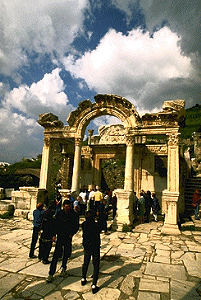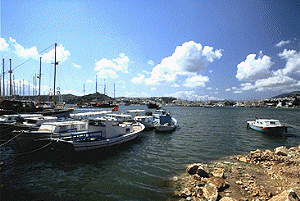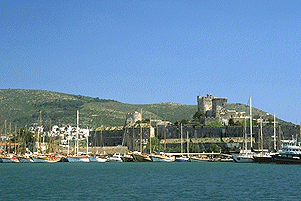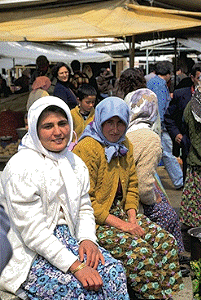Click here for www.PriceLine.com
By Richard Carroll / Photography Donna Carroll
During the flight, a German archaeologist, whose long hair has a somewhat biblical quality, informs us that we are headed smack dab to the center of world history; civilizations dating from 8,000 B.C., and a region noted as the world's largest open air museum. "If I had the choice of only one location in the world to study and research, this would be it," he says.

A one-hour drive south from Izmir to Ephesus, through fertile valleys with neatly planted olive trees, orchards and villages where storks are nesting comfortably atop chimneys, we see large columns rising to the sky and the ruined classical city poised as elegantly as a ballet dancer.
Selcuk, two miles west of the site, has a splendid museum with statuary embracing the history of Ephesus, but who can wait? We head for the site.
The ongoing archaeological excavations, begun in the 1860s, uncovered an ancient Ionian city noted as the largest and most important in antiquity during the 1st century A.D., and under Augustus became the first city of the Roman province of Asia.
Walking along Marble Way, the main passageway, history and ancient peoples are suspended in time for a few hours as we try to comprehend the colossal scope of the two-story Celsus Library, (A.D. 110) supported by 16 towering columns, the perfectly intact 24,000-seat theater, the largest in Asia Minor, the baths, temples, facades, sculptures and chariot tracks that have been grooved into the marble.
Walk through with a guide, then leisurely retrace your steps with a guidebook. Carry water and wear a large floppy hat. The sun can be unrelenting.
On castle-capped Ayasoluk Hill in Selcuk is the ruined Justinian's 6th century Church, or Basilica, of St. John variously associated in the early middle ages with the death or bodily assumption of St. John. Near the basilica is the Isa Bey Mosque appearing like a grounded flying saucer with its typical Selijuk portal and large dome.
Six miles south is the small, narrow House of the Virgin Mary, thought to have been the place where St. John brought the mother of Christ after the Crucifixion. Pope Paul VI and Pope John Paul II visited the shrine as do Muslim and Christian pilgrims from throughout the world.
Kusadasi, 12 miles south of Selcuk on the Aegean, and transformed from a lazy fishing village to a thriving cruise ship port, is another base for travelers exploring the region who would like a taste of nightlife and the opportunity to mingle with Europeans who are smitten by archaeology.
Following in the footsteps of Alexander The Great, the Crusaders, and other ancient armies, we drive 105 miles south from Kusadasi to Bodrum past groves of fruit trees, horse-drawn carts and ruins lost in history. We see a crusty 13th century bridge now used by robed ladies when gathering firewood; a ruined tower in the middle of a plowed field, sagging walls where goats doze and worn marbled paths leading nowhere.

Bodrum, Turkey's Bohemian version of Spain's Costa del Sol, is a hilly, all-white, sun-bleached town. Its narrow, winding streets are jammed with appealing sidewalk cafes overlooking a glorious natural yacht harbor and dominated by the 1402 Knights of Rhodes castle. Here also is the Museum of Underwater Archaeology.
During the summer, Bodrum is alive with the "not-quite-jet-set-crowd," entertained by goofy resort disco music, and harbor-front cafes offering live Turkish music as well as the mornings catch. With more bars than mosques, the town, at times, has the feel of Hemingway's Key West or Cabo San Lucas at the tip of Baja.
Visitors can book a cruise along the southeastern coast on the Bodrum-style wooden, two-masted sailing boats and experience secluded coves and villages, historic sites, and dive in crystal-clear water a stone's-throw from Greece.

At the great castle that is ensconced on a rocky harbor promenade, you can browse through the world's largest underwater archaeology museum. Artifacts from the Aegean include a 4th century, late Roman shipwreck, a 7th century Byzantine shipwreck, and hundreds of items such as pottery, gold and jewelry retrieved by local sponge divers.
The castle also has a spine-tingling dungeon with all the torture gadgets intact and towers built at various times by the English, French, Italian, German and Spanish.
Driving inland from Bodrum, we head to Aphrodisias and Pamukkale (pah-MOO-kah-leh), a half-day drive, through the market town of Milas and past rock-strewn canyons, mountain ranges, pine forests and cotton fields.
Wonderfully remote Aphrodisias, site of the huge 30,000 Greco-Roman stadium used for chariot races, thrills us to the bone. A theater with great acoustics and the imposing Temple of Aphrodite showcase the Aphrodisias craftsmen, celebrated throughout the Roman empire for their delicate work in marble.
The museum is bursting with statuary lined up like cadavers frozen in blocks of ice; the head of Apollo; a high priest of Aphrodite, an earthy pugilist, a full-body statue of Flavius and scores of others who once wandered the land.
At Pamukkale, an hour's drive from Aphrodisias, rock formations, pools and basins, have been carved into the side of the mountain by salt-laden, hot, spring water. The vistas are among Turkey's best as you look out at a large valley framed by snow-capped mountains and drifting clouds.
Adjoining is Ancient Hierapolis and Lydian tombs where vendors with their white embroidery are in stark contrast to massive stone arches.
From Izmir, back on the Aegean, we motor 56 miles east to Sardis, dating from 334 B.C. when Alexander the Great took the city. The ruined Temple of Aremis with its 14 columns, a 5th century Christian Temple, an historic Roman road and the adjoining Jewish shops, synagogue and beautifully restored gymnasium facade are a marvel.

For all the history, the Turkish people are the number one attraction. A young boy approaches offering an authentic Roman coin. In perfect English he says, "On second thought it's not authentic, but it's a nice souvenir." We couldn't resist. Turkey is a charmer.
For information contact the Turkish Tourist Offices in Washington D.C. at (202) 429-9844; New York (212) 687-2194; Turkish Airlines at (800) 874-8875.